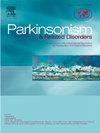帕金森病伴步态冻结的步态启动缺陷:预估姿势调整的大规模力平台研究
IF 3.4
3区 医学
Q2 CLINICAL NEUROLOGY
引用次数: 0
摘要
步态冻结(FoG)是帕金森病(PD)中一种使人衰弱的运动症状,通常发生在步骤开始时,由于预期姿势调整(APAs)受损。先前的研究显示,在PD伴FoG (PwPD + FoG)和不伴FoG (PwPD-FoG)的患者中,关于APA改变的发现不一致。本研究旨在通过一个力平台来评估与FoG相关的姿势控制缺陷,以研究APA的特征。方法分析130例PwPD患者(70例合并FoG)和41例健康对照者的基线数据。在自我启动的步进过程中,一个力平台测量了APA持续时间、幅度和步进幅度。所有PD患者均接受ON药物测试。采用单因素方差分析和方差分析(控制UPDRS-III和用药)进行组间比较。结果与PwPD + FoG和PwPD-FoG相比,健康人的apa持续时间明显缩短,PD组之间无差异。PwPD + FoG组的阶跃幅度明显低于Healthy组和PwPD-FoG组,但协变量后差异不显著。APA中外侧振幅PD + FoG <;PD-FoG & lt;健康;ANCOVA证实PwPD + FoG值低于PwPD-FoG值。与PwPD-FoG和健康组相比,PwPD + FoG组的APA正位振幅也降低,ANCOVA证实PwPD + FoG组的APA正位振幅明显低于PwPD-FoG组。NFOG-Q评分与中外侧和正后侧APA波幅呈负相关。结论PD患者的fog与APA振幅(中外侧和正后方)降低有关,提示尽管多巴胺能药物治疗,但姿势控制缺陷仍然存在。这些发现强调了以APA改善为目标的干预措施对于减轻PwPD + FoG患者步态启动失败的重要性。本文章由计算机程序翻译,如有差异,请以英文原文为准。
Gait initiation deficits in Parkinson's disease with freezing of gait: A large-scale force platform study of anticipatory postural adjustments
Introduction
Freezing of gait (FoG) is a debilitating motor symptom in Parkinson's disease (PD), often occurring during step initiation due to impaired anticipatory postural adjustments (APAs). Previous studies show inconsistent findings regarding APA alterations in people with PD with FoG (PwPD + FoG) and without FoG (PwPD-FoG). This study aimed to investigate APA characteristics using a force platform to assess postural control deficits associated with FoG.
Methods
We analyzed baseline data from 130 PwPD (70 with FoG) and 41 healthy controls. A force platform during self-initiated stepping measured APA duration, amplitude, and step amplitude. All participants with PD were tested in the ON medication. One-way ANOVA and ANCOVA (controlling for UPDRS-III and medication) were conducted to compare groups.
Results
APA duration was significantly shorter in Healthy compared to PwPD + FoG and PwPD-FoG, with no difference between PD groups. Step amplitude was significantly lower in PwPD + FoG compared to Healthy and PwPD-FoG, but this difference was insignificant after covariate. APA mediolateral amplitude followed PD + FoG < PD-FoG < Healthy; ANCOVA confirmed lower values in PwPD + FoG compared to PwPD-FoG. APA anteroposterior amplitude was also reduced in PwPD + FoG relative to PwPD-FoG and Healthy, with ANCOVA confirming significantly lower values in PwPD + FoG versus PwPD-FoG. NFOG-Q scores were negatively correlated with mediolateral and anteroposterior APA amplitudes.
Conclusion
FoG in PD is associated with reduced APA amplitude (mediolateral and anteroposterior), suggesting postural control deficits persist despite dopaminergic medication. These findings highlight the importance of interventions targeting APA improvements to mitigate gait initiation failures in PwPD + FoG.
求助全文
通过发布文献求助,成功后即可免费获取论文全文。
去求助
来源期刊

Parkinsonism & related disorders
医学-临床神经学
CiteScore
6.20
自引率
4.90%
发文量
292
审稿时长
39 days
期刊介绍:
Parkinsonism & Related Disorders publishes the results of basic and clinical research contributing to the understanding, diagnosis and treatment of all neurodegenerative syndromes in which Parkinsonism, Essential Tremor or related movement disorders may be a feature. Regular features will include: Review Articles, Point of View articles, Full-length Articles, Short Communications, Case Reports and Letter to the Editor.
 求助内容:
求助内容: 应助结果提醒方式:
应助结果提醒方式:


